Member Tank Thread: http://www.reef2reef.com/forums/reef-aquarium-discussion/55423-tank-birthday-40-years.html

I am honored that Reef 2 Reef would feature my reef this month. It is not the nicest looking reef and it does not have wall to wall corals. It's just a tank that has evolved over time to look like it looks. My family owned a sea food business so I grew up with fish. Mostly dead fish but since I spent so much time with fish, it was normal that I should keep them alive. I started my first tank sometime in the 1950s. I bred freshwater fish until 1969 when I got drafted in the the Army. In the early 70's, no one kept salt water fish. Luckily for me, I traveled to Australia when I was on R&R from Vietnam and went on my first SCUBA dive. A girl I met got me all equipped for diving and took me diving on the Great Barrier Reef. I was in awe and when I returned home to the US, I got certified as soon as I could. When ever possible, I would travel to a location where fish would be that I was interested in and try to dive with them to learn their secrets. That is how I learned about moorish idols. I went to Bora Bora with my wife who also dives, and spent time with them underwater. I now have almost 300 hours underwater and still find plenty of things to learn. I have my own boat and equipment so it is a little easier. When I returned home from the Army in 1971, saltwater fish started to be imported into the States and that's when I started my first 30 gallon tank. In those days, there was nothing available for salt water tanks so I collected water in the sea near New York City.
For the substrate, I used driveway gravel as there was nothing available except colored fresh water gravel. Eventually, I discovered dolomite and that is what is in my tank today. In those days, all fish had ich and little was known about it. What was known was that copper would cure it. Liquid copper was not available so I used copper pennies, 20 pennies to the gallon. If you used too many pennies or left them in to long, the fish would lay on the bottom. Then, you removed some pennies. It worked well but took some getting used to.
In 1978 I moved into a new home and brought the tank with me but I transferred everything in it to a 6' long, 14" high, 100 gallon glass tank. (I don't remember the manufacturer) The tank, like all tanks utilized an under gravel filter which was a disaster, and in time I tweaked it to be a reverse under gravel system and that is still the system today. The tank has never crashed and has never been emptied.
The tank consists of LPS and SPS corals along with about 20 fish. Some of the corals are over ten years old, maybe older as small pieces break off and grow wherever they fall. There would be much older corals but if you keep a tank long enough accidents happen, usually when you are away. My tank sitter allowed the water level to fall by about 7", killing any corals above that including a very large acropora.
Almost all the fish are spawning including the mandarins and 23 year old fire clowns. My blue stripe pipe fish started to spawn constantly, but they have very short lifespans of only a few years so I don't have them any longer. Clown gobies also spawn continousely but their egg laying activity kills the acropora where they deposit their eggs. They always pick a new spot so eventually, they will kill the entire coral. There is also a pair of pistol shrimp that I think are spawning as they have been living in the same tunnel with their Watchman friend for over a year. A few years ago my 12 or 13 year old hermit crabs died and I also feel they were spawning.
The tank was started like all tanks in those days with dead coral skeletons. There was no rock or live coral for sale then. I collected asphalt in the sea that was very porous and filled with amphipods. I knew it was underwater for over fifty years and I correctly assumed that it was safe to use. I would not use asphalt unless I was sure it was underwater for at least that long. Eventually, I filled the tank with live rock that I collected mostly in the Caribbean by SCUBA diving. In those days, it was legal to collect and carry on a plane. Much of that original rock, I replaced with hollow rock that I build by putting cement over bent up PVC conduit. I like the homemade rock better than real rock and it has the advantage of being hollow offering more area for bacterial growth.
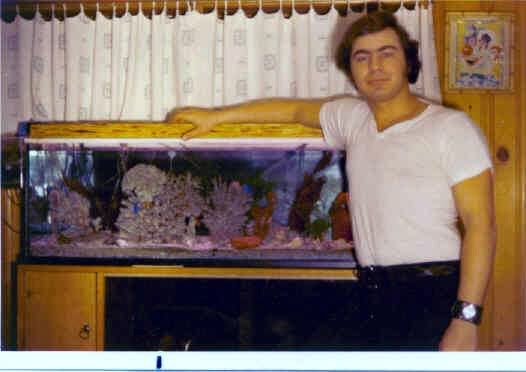
Filtration:
The filtration consists of the reverse UG filter. The "filter" was built by plumbing the three "uplift" tubes from the UG plates together and bringing them up in the back on one end of the tank. They all enter the bottom of a container that is just above the water and are fed from a submerged powerhead that has a sponge over the intake. Water is pumped down to the UG plates "very slow" and I have found this system will last forever with very little maintenance. You will probably not find another tank filtered this way as I think I devised this system and perfected it many years ago .
In the 43 years this tank has been running the power has gone off many times, sometimes for 3 or 4 days but nothing ever happened to the tank. Here in New York, we experience hurricanes and snow storms that knock down power lines.
I built the HOB skimmer many years ago from some 4" PVC and some acrylic tubing. It is five feet tall and also features a home made venturi valve that is run by two pumps. Ozone is injected into the skimmer at 200mg/hr. I don't use the controller on the Ozonizer as I want as much Ozone in there as I can produce. It all gets disapated in the large skimmer and algae trough. I built my first ozonizer but later had to buy one as my DIY unit didn't produce enough ozone and it was noisy (and probably dangerous).
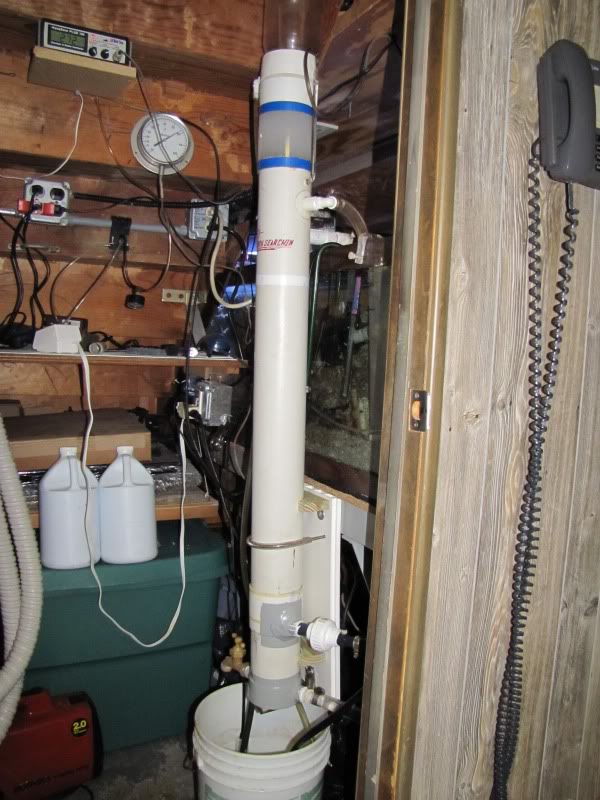
DIY skimmer
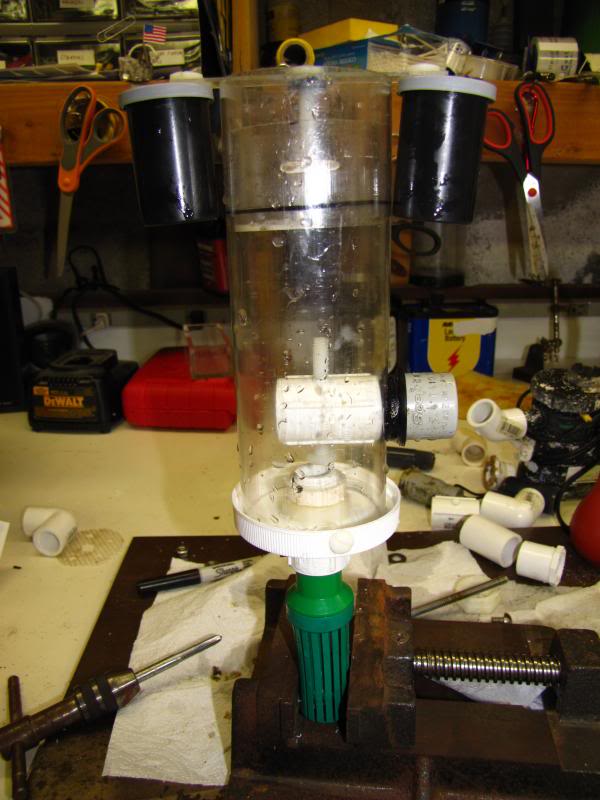
DIY surface skimmer to feed protein skimmer as no sump is used
Above the water and to the rear of the tank is an algae trough or scrubber that is almost as long as the tank. Water from the skimmer flows across the trough and back into the tank. There are LEDs over the trough to light it and there is also a plastic screen in it that can be rolled up, removed and cleaned of algae. It was designed to provide a place for algae to grow away from the main tank or on the corals. Unlike many people, I want algae growing and get worried if I don't see algae. The trough is made from a PVC downspout that I sliced in half. That algae trough is presently populated with hard shelled tube worms that completely fill the space. I find them to be excellent water purifiers and I feel they multiply so fast due to the clams I feed almost every day along with their associated clam juice.
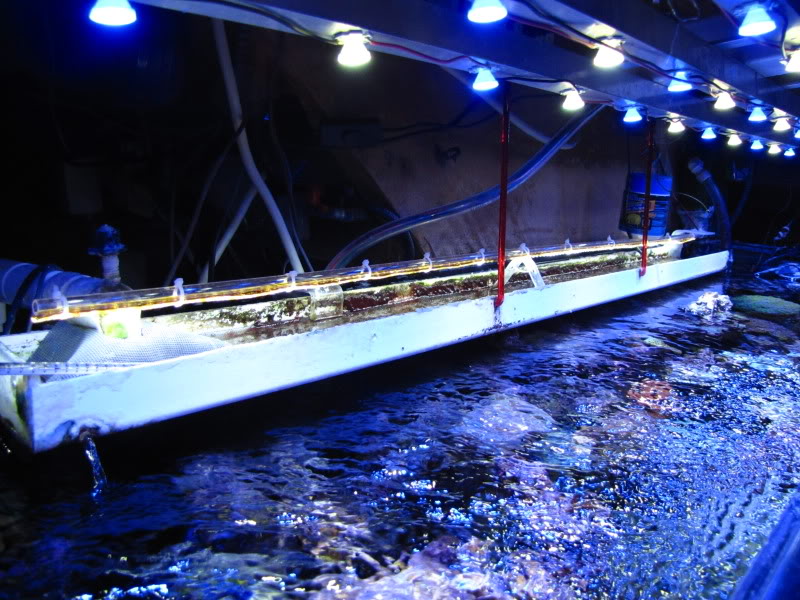
Algae trough and DIY LEDS
The circulation consists of two Korilia pumps, one at each side of the tank. The tank does not use a sump as they were not invented when I set up the tank. The pumps are old and I do not know the volume they pump, but the two pumps are faced at an upward angle and roll the water nicely.
Temp Control:
There are two heaters as here in New York it gets well below freezing all winter. Our temperature in the summer gets up to 100 degrees F. I have a home made chiller but after I replaced the MH lights with LEDs I have not needed it.
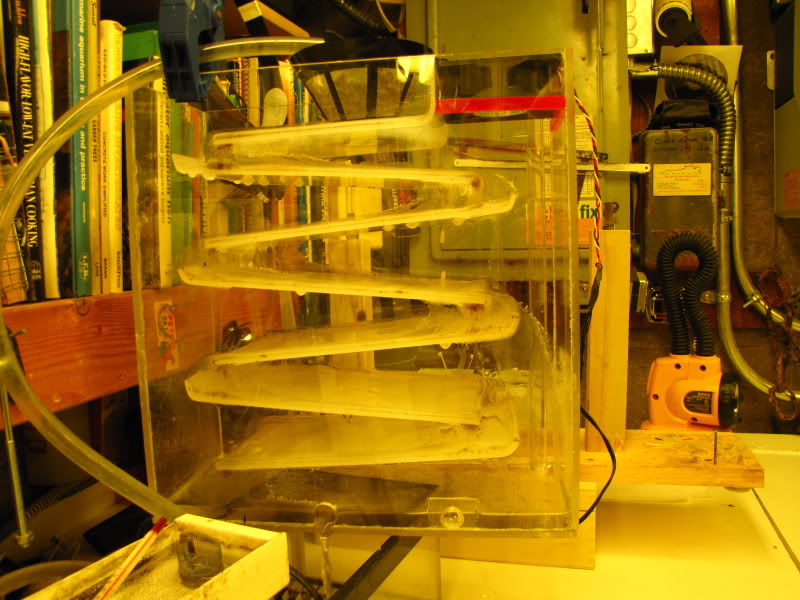
DIY Chiller
Lighting:
Lighting has gone from incandescent bulbs in the early days to regular flourescent lamps to VHO lamps to PC lamps to MH lamps to what I have today which is a home made LED system. There are 36 3 watt LEDs. Half are white and half are blue. The fixture is hung on stainless steel cables and is counter weighted. Just a touch raises the fixture up and out of the way. The tank is built into a wall so none of this is visable. The LEDs are on for about 12 hours a day.
No other equipment is used, no dosers controllers or reactors. There is a home made surface skimmer that feeds the protein skimmer. It skims the very top layer of water by the use of floats that keep the top of the surface skimmer just below the surface.
A home made ATO brings water up over the ceiling from another room where the automatic RO/DI system is. The RO/DI fills a bucket that is suspended from the ceiling and feeds the tank by gravity to a float switch. There is a home made shut off switch on the bucket that turns off the water from the RO/DI so it does not over fill.
Food:
I try to keep the tank natural and food is live California blackworms and clams. I buy the clams live and freeze them. I alternate frozen mysis with the clam but they get the live worms every day. I also feed live newborn brine shrimp every day that I hatch in a home made hatchery that separates the eggs from the shrimp. The live shrimp are fed to the fish using a home made baby brine shrimp feeder that I designed. I also invented and patented an adult brine shrimp feeder that was used to feed seahorses. The new born shrimp feeder is used to keep my mandarins spawning. There is also an automatic feeder above the tank that is mainly for the night time eaters. It is filled with sinking pellets that are soaked in fish oil. I could not keep pipefishes without the feeder and live baby brine shrimp and if it were not for live worms, I could not, and would not have this tank as that is the key to keeping everything as healthy as possible.
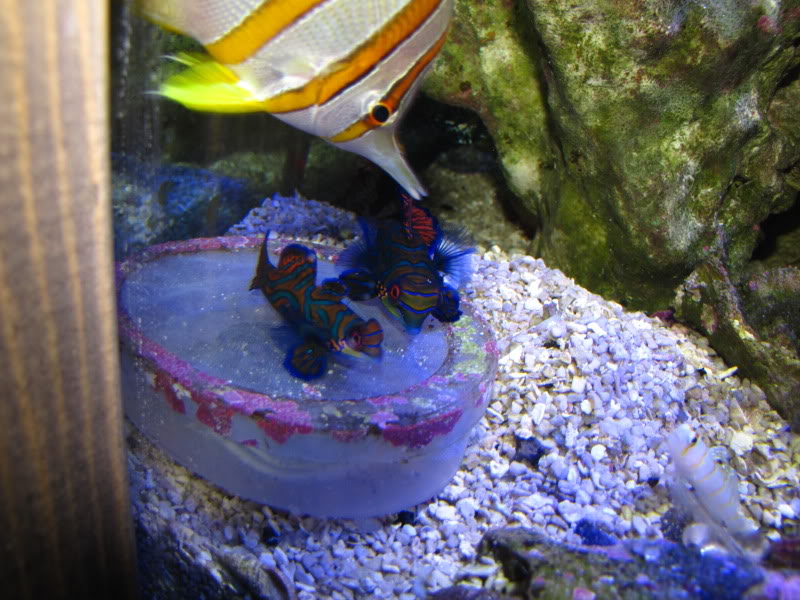
Spawning mandarins eating freshly hatched brine shrimp from feeder
Maintenance:
Maintenance on this tank is very little. Besides cleaning the glass, once or twice a week I add some driveway ice melter and baking soda for the calcium and Alk. That's my dosing regimen. I can't tell you the parameters because I don't test unless there is a problem and that has not happened in many years. About five years ago, a commercial test company tested the water for free. Ss they wanted to see what the parameters were in such an old tank. Most of the parameters were fine. I did recently have a LFS test the nitrates and they are about 40. For most of the life of the tank, they ran about 10, but last year I went to Germany for vacation and my tank sitter let the water level drop by 1/3rd and all of the corals above that line died as they were above the water. The nitrates went up and stayed there. I know this is high for my tank but I do not want to lower them because the tank has never looked better. All the corals are growing nicely so I will keep the nitrates where they are. A LFS also recently tested my Phosphates and they are about .25 These readings are considered hign in a normal, modern tank but they don't seem to have any negative effects so I do not want to lower them at this time. As a matter of fact, I think the tank looks better than it ever has. I feel this is the case because I use a reverse undergravel filter and dolomite gravel. Also about once a year, I stir up the gravel where I can reach and suck out the detritus with a diatom filter (or canister filter). That is about the extent of the maintenance.
Three or four times since 1971, I removed most of the rock and did a more thorough cleaning. In those instances, I wanted to remove the rock to re-aquascape anyway so while I was at it, I stirred up the gravel and sucked out the detritus. I can't really do that now because pipefish don't survive such an ordeal as I think their tiny gill openings get clogged. There are also to many corals that kind of glue the rocks together.
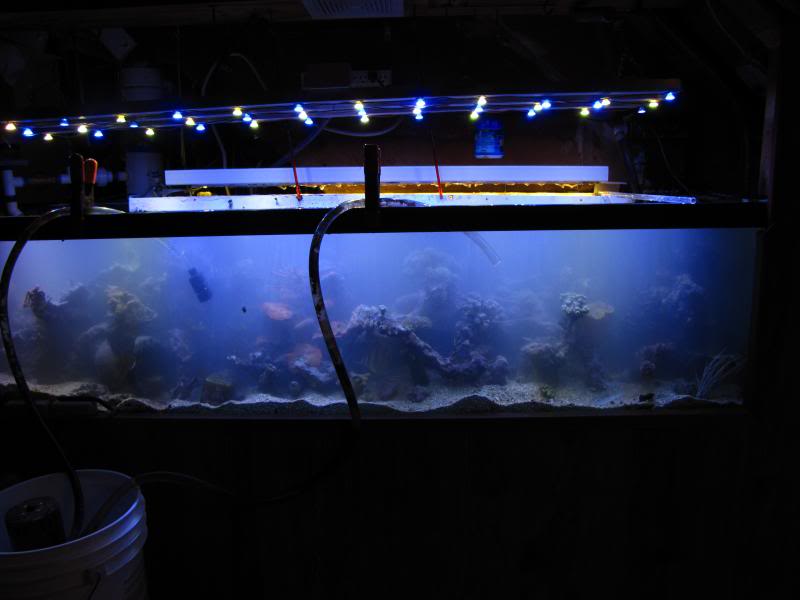
Diatom filtering tank once a year
Water changes amount to 20% about 5 times a year, a small portion of that water is NSW that I collect here in the summer. I also collect and add bacteria in the form of mud. I collect small amounts of mud in a local bay and put it in a container in my tank for a few days, then I remove the mud as I only want the bacteria. I also collect amphipods that I release in the tank a few times a year. I feel the bacteria and amphipods help the tank maintain a natural feel and allows natural processes to occur while adding to the food chain for the tiny creatures that provide food for larger creatures and eventually the fish and corals
.
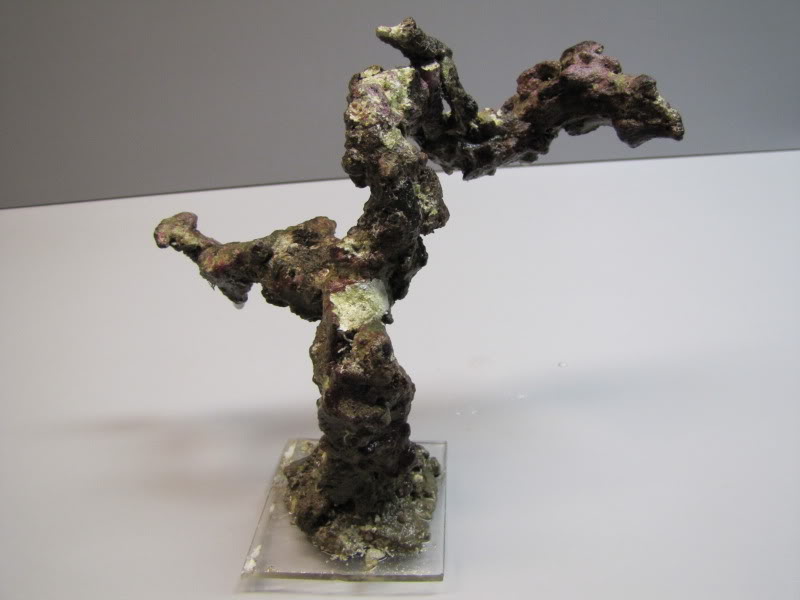
Homemade "rock"
Livestock:
Homemade "rock"
I am not very good with names. Most of the animals, I acquired a long time ago so I can't name many of the corals. I will name the ones I know.
The tank is filled with quite a few different gorgonians. They grow like weeds and sprout all over the place.
There is also quite a few montiporas. They have a hard time because the other corals, namely the torch corals and sea fans grow faster and kill parts of the montipora so it tries to grow in another direction. Then something there stings it and it grows a different direction. It is interspersed all over the tank. Due to that, there are dead dead pieces of it all over the place. But, it is a fast grower and keeps trying to find places to grow.
There is also quite a bit of acropora. As you know that coral is very brittle. So many times, I stick my hand in the tank and break it. Due to that, I also have pieces of that growing all over the tank. A large piece of it is having a hard time and much of it died because a pair of clown gobies spawn on it at least once a week. I would rather have the clown gobies spawning than a healthy acropora. This is because the gobies always stay on that coral. So far have not spawned on other specimen. So, I just sacrifice that one. Healthy fish spawn and I want all my fish healthy.
The other corals consist of leathers, mushrooms, hammars, frogspawns, zinia, and a few SPS and LPS that I can't name and forgot when I got them. There is also a very large blue sponge that covers almost a quarter of the tank. I often cut off pieces and give them away.
The fish are:
- 1 copperband butterfly
- 1 possum wrasse
- 7 assorted cardinals (4 of them spawning)
- 2 mandarins (spawning)
- 2 fireclowns 23 years old (spawning)
- 2 watchman gobies (spawning)
- 1 scooter dragonette
- 1 sizzortail gobi
- 3 small unknown gobies
- 2 clown gobies (spawning)
- 2 Bangai cardinals (spawning)
- 1 dragon faced pipefish
- 1 multibanded pipefish
- Unknown number of hermit crabs (a pair recently died that was 12 years old)
- 1 long spine urchin
- 2 pistol shrimp (I think they are spawning but not sure)
- unknown number of local New York mud snails.
- I occasionally get some majano anemones that I eliminate with the Majano Wand that I invented and patented.
Pregnant pipe fish
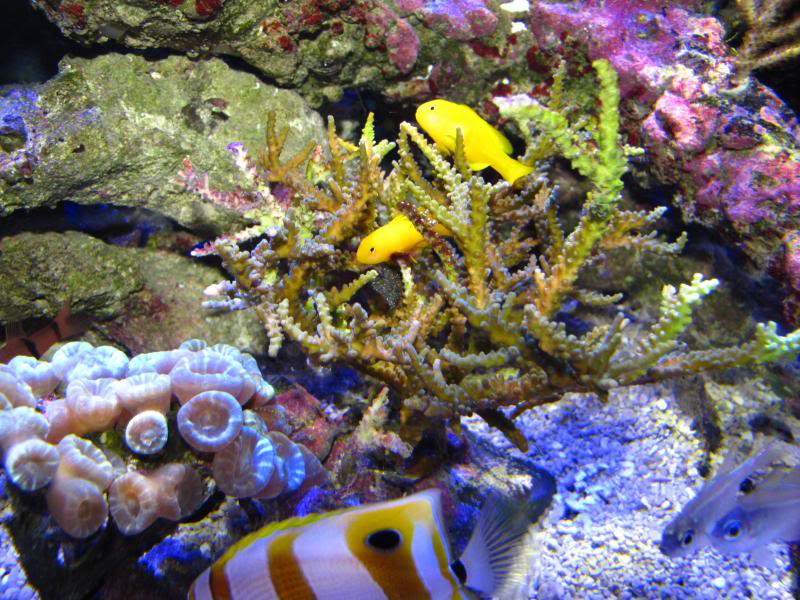
Spawning clown gobies
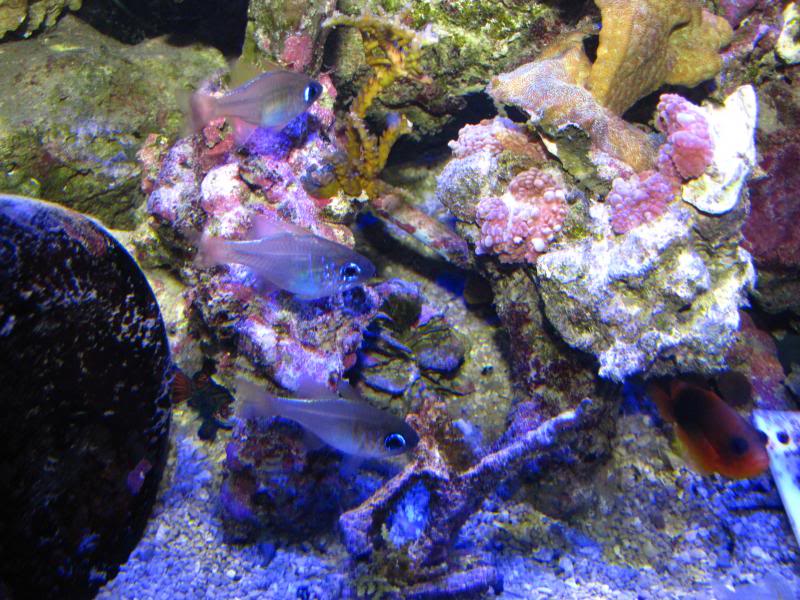
Spawning threadfin cardinals
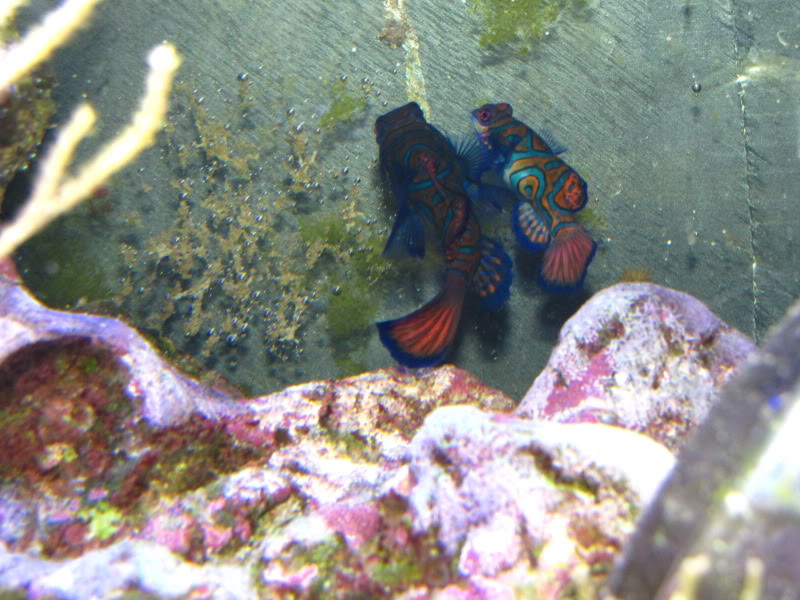
Spawning mandarins
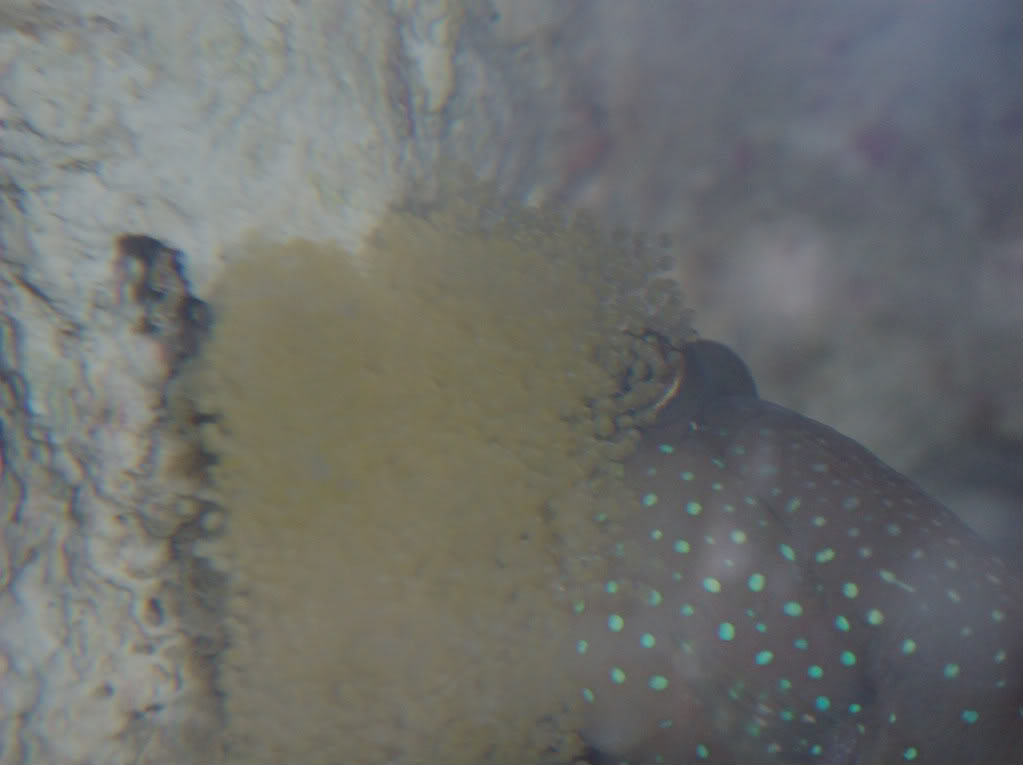
Watchman goby with eggs
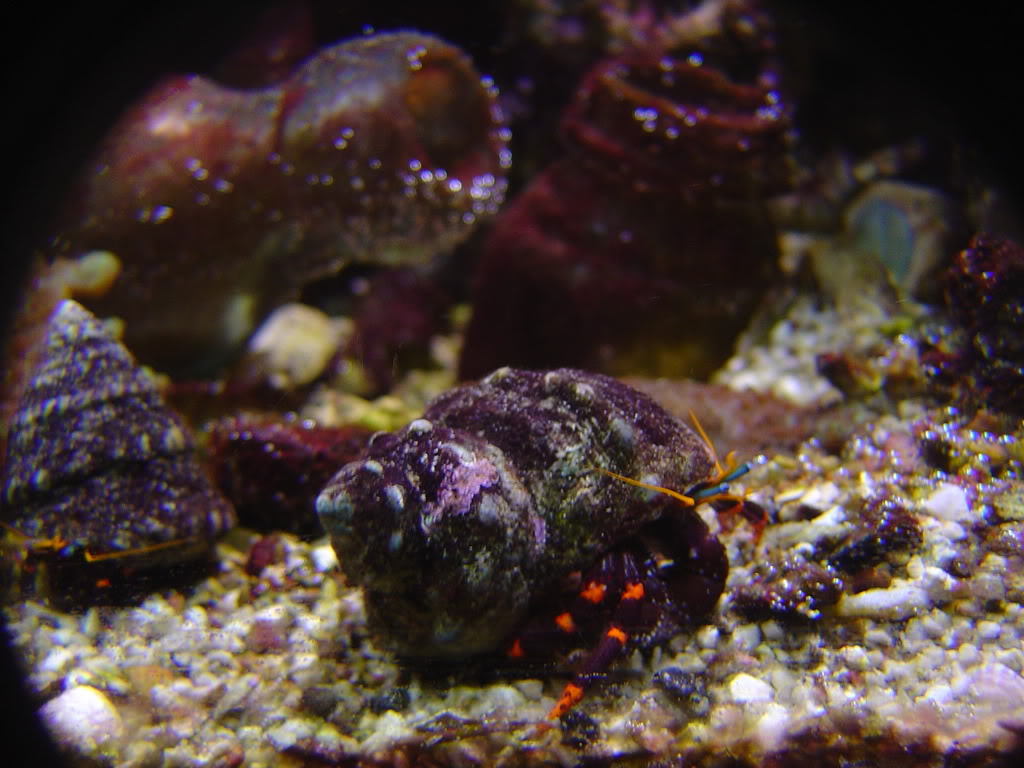
12 year old hermit crabs
Conclusion:
Many people tell me my tank is very old school or just weird. It is definitely old school as it was started the same week that salt water animals became available in the States, but it is not weird. It was set up the normal way and the only way a tank could have been set up decades before the internet was invented. Today virtually all tanks look and are run the same way or very similar. Since this tank was set up, it has gone through all the fads of the era such as wet dry and various lighting of the time. It has evolved over time to what it is now.
I strive to keep it natural and have as many fish spawning as I can. Spawning fish are healthy fish and all fish should be spawning or at least making spawning gestures. Due to the health of the inhabitants that I attribute to the live foods, I do not have to quarantine and have no use for a hospital tank. There has not been a disease or parasite in over 30 years. Although I often aquire "almost" dead animals from an LFS who can't save them and set up a small tank for them. I got many of my current fish in that manner. If fish get too large, I donate them to a public aquarium. I depend on the healthy immune systems of the fish to protect them and so far, it works well because I feel that spawning fish rarely, if ever get sick. If any of my paired fish are not spawning, I consider that a failure and try to remedy that situation.
In the early 70s, there were hardly any books about salt water fish, but the one that stands out and the author that I respect the most was Robert Straughn who wrote "The Salt Water Aquarium in the Home". It was written in the fifties and I still have it. Mr. Straughn was a diver which was rare in those days and he seemed to have collected and kept just about everything. There were no captive corals then and very little was known about the role of bacteria in the tank but his knowledge of fish was awesome. I learned a lot from him.
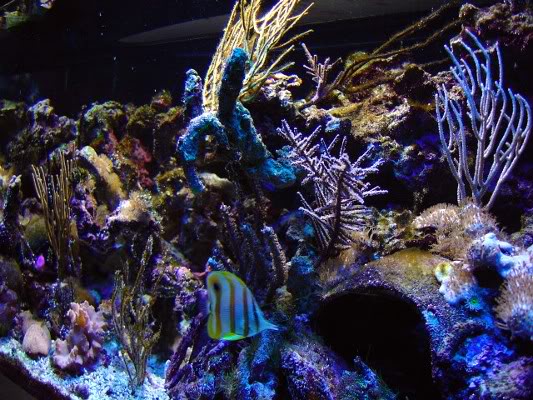
Tank around 2000












